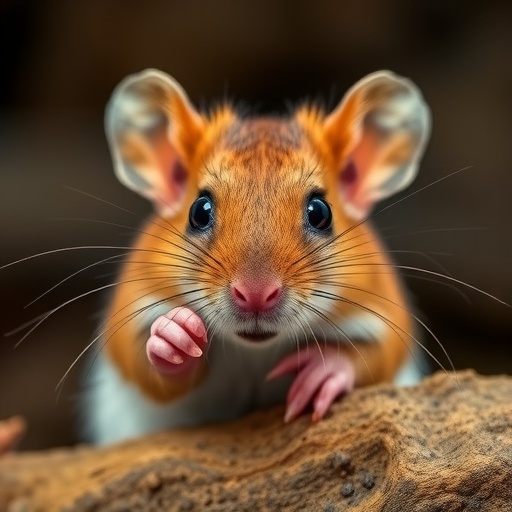In the vast tapestry of mammalian evolution, rodents hold a special place—not only due to their sheer diversity, comprising nearly 40% of all mammal species, but also because of an evolutionary innovation that has long gone unnoticed: the presence of thumbnails. Unlike the typical sharp claws that characterize most mammals, certain rodents possess smooth, flat nails on their thumbs – an adaptation thought to amplify their manual dexterity. This discovery, grounded in comprehensive museum research, sheds new light on how rodents diversified and came to occupy almost every terrestrial habitat on Earth.
The origins of this fascinating trait remained elusive for centuries. Observations of squirrels grasping acorns with apparent precision sparked curiosity among naturalists, but a systematic investigation across the rodent family tree had never been undertaken—until now. Leveraging one of the world’s largest mammalian collections housed at Chicago’s Field Museum, a team of researchers embarked on an ambitious project to document whether thumbnails or claws were predominant across multiple genera of rodents. This research paves a novel path for understanding morphological evolution in relation to survival and ecological success.
Using more than 400 genera representing a substantial portion of rodent diversity, the research team meticulously examined preserved specimens, paying close attention to the morphology of their thumbs, an often-overlooked element of their anatomy. Their findings were striking: approximately 86% of the surveyed genera included species sporting thumbnails instead of claws. Intriguingly, these thumbnails were not a recent novelty but traced back to a common ancestor shared among modern rodents, suggesting deep evolutionary roots for this trait.
The functional implications of these thumbnails hint at a sophisticated evolutionary advantage. Rodents with nails on their thumbs exhibit greater manual dexterity—allowing them to manipulate and handle food sources with significantly more precision than species equipped with claws. This enhanced dexterity is particularly advantageous when consuming high-energy, challenging-to-access foods such as nuts. Unlike claws, which are primarily adapted for digging or defense, the flat nails presumably facilitate gripping and manipulating small objects, offering an adaptive edge in environments where food acquisition is competitive.
Intriguingly, this morphological feature correlates strongly with feeding behavior. Rodents lacking thumbs, and by extension thumbnails, tend not to use their hands for food handling, relying instead solely on their mouths to process food. This behavioral trait aligns with their anatomical constraints, underscoring the interplay between form and function. The researchers supplemented their anatomical data with extensive reviews of feeding habits via citizen science platforms like iNaturalist, as well as canonical scientific literature, to build a composite picture of how thumb morphology intersects with ecological niche exploitation.
Beyond feeding, the presence or absence of thumbnails among rodents is linked to their ecological lifestyles and locomotion strategies. Species that live arboreally—those residing in trees or aboveground habitats—are more likely to possess thumbnails, while fossorial rodents adapted to digging and subterranean life generally have claws. This association parallels similar trends observed in primates, including humans, where nails assist in specialized manipulations required in complex three-dimensional habitats like forests.
While primates are most famously known for their nails as opposed to claws, the study determines that rodent evolution of thumbnails and primate nail development are cases of convergent evolution. These lineages independently arrived at similar solutions to challenges involving manual dexterity, indicative of parallel evolutionary pressures acting on distinct mammalian groups to facilitate manipulative capabilities that unlock diverse ecological opportunities.
This research not only enriches our understanding of anatomical adaptations in rodents but also illustrates the power of museum collections as invaluable repositories for evolutionary biology studies. The preserved specimens, originally collected without the anticipation that their thumbnails would attract such focus, proved crucial for an analysis that spans the rodent evolutionary tree with remarkable breadth and depth. The importance of sustained, detailed natural history collections thus emerges as a central theme: they are treasure troves for future discoveries waiting to be uncovered.
The discovery also invites broader reflections on the rapid speciation and ecological success of rodents. Their ability to contend with complex food resources, enabled in part by thumbnail development, might be one of the key factors explaining their phenomenal diversity and nearly worldwide distribution. From urban environments to dense forests, rodents’ manual dexterity facilitated by thumbnail evolution arguably allowed them to carve out niches inaccessible to many other mammalian groups.
From an anatomical perspective, the nails on rodent thumbs do not merely signify a superficial change but represent intricate developmental modifications. This adaptation may involve changes in keratinous structures, bone morphology, and the musculature supporting the thumb’s enhanced functionality. Understanding the genetic and developmental mechanisms behind such transformations may yield important insights into vertebrate limb evolution and the plasticity inherent in mammalian morphology.
Moreover, contrasting rodents with other small mammals underscores unique evolutionary trajectories within mammals. While other clades tend to maintain claws suited for grasping or digging, the diversification and specialization of rodents’ thumbs highlight how selective pressures shape morphology in alignment with ecological demands. These evolutionary insights could further inform the design of biomimetic applications where precision gripping is essential.
In summary, the intersection of morphology, behavior, and ecology unveiled in this study not only clarifies a long-standing question about rodent anatomy but also highlights evolutionary convergence and innovation. The widespread presence of thumbnails across Rodentia reveals an ancient trait critical to their ecological success, bridging anatomical form with functional necessity. As researchers continue to delve into museum archives and incorporate multidisciplinary approaches, our understanding of how small mammalian adaptations facilitate vast biodiversity will deepen, offering a richer narrative of life’s evolutionary intricacies.
Subject of Research: Animals
Article Title: Evolution of thumbnails across Rodentia
News Publication Date: 4-Sep-2025
Web References: 10.1126/science.ads7926
Image Credits: Photo credit: Field Museum.
Keywords: Animal science, Evolutionary biology, Evolution, Evolutionary ecology, Organismal biology, Anatomy, Animal physiology, Animals, Morphology, Natural history




